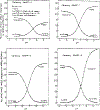Optical measurements of pH using fluorescence lifetimes and phase-modulation fluorometry
- PMID: 8368522
- PMCID: PMC6816262
- DOI: 10.1021/ac00061a007
Optical measurements of pH using fluorescence lifetimes and phase-modulation fluorometry
Abstract
We measured the pH-dependent fluorescence decay times of the seminaphthofluoresceins (SNA-FL), seminaphthorhodafluors (SNARF), and BCE-CF using phase-modulation fluorometry. The phase and modulation values were found to be strongly pH-dependent in the physiological pH range, over the easily accessible range of light modulation frequencies from 10 to 300 MHz, making these probes useful as lifetime-based pH sensors. The phase and modulation values are dependent on excitation and emission wavelength as well as pH. This dependence allows the range of pH sensitivity to be chosen by selection of the wavelength(s) and enables increased precision of the pH measurements by use of phase and/or modulation measurements at several wavelengths. These probes can be excited using a a green He-Ne laser at 543 nm, which allows their use in low cost instrumentation. Phase and modulation measurements are especially suitable for sensing applications because they are insensitive to the changes in signal intensity that result from photobleaching, probe washout, and/or light losses.
Figures








Similar articles
-
Lifetime-based pH sensors: indicators for acidic environments.Anal Biochem. 1999 Apr 10;269(1):162-7. doi: 10.1006/abio.1999.4011. Anal Biochem. 1999. PMID: 10094788 Free PMC article.
-
Long-lifetime metal-ligand pH probe.Anal Biochem. 1997 May 1;247(2):216-22. doi: 10.1006/abio.1997.2057. Anal Biochem. 1997. PMID: 9177680 Free PMC article.
-
Generalization of the Ratiometric Method to Extend pH Range Measurements of the BCECF Probe.Biomolecules. 2023 Feb 26;13(3):442. doi: 10.3390/biom13030442. Biomolecules. 2023. PMID: 36979377 Free PMC article.
-
Determination of intracellular pH in phytoplankton using the fluorescent probe, SNARF, with detection by fluorescence spectroscopy.J Microbiol Methods. 2018 Sep;152:109-118. doi: 10.1016/j.mimet.2018.07.023. Epub 2018 Aug 2. J Microbiol Methods. 2018. PMID: 30077695
-
Potential applications of lifetime-based, phase-modulation fluorimetry in bioprocess and clinical monitoring.Trends Biotechnol. 1995 Mar;13(3):106-15. doi: 10.1016/S0167-7799(00)88915-5. Trends Biotechnol. 1995. PMID: 7766217 Free PMC article. Review.
Cited by
-
Depth penetration and detection of pH gradients in biofilms by two-photon excitation microscopy.Appl Environ Microbiol. 1999 Aug;65(8):3502-11. doi: 10.1128/AEM.65.8.3502-3511.1999. Appl Environ Microbiol. 1999. PMID: 10427041 Free PMC article.
-
Fluorescence lifetime imaging microscopy: homodyne technique using high-speed gated image intensifier.Methods Enzymol. 1994;240:723-48. doi: 10.1016/s0076-6879(94)40069-5. Methods Enzymol. 1994. PMID: 7823855 Free PMC article.
-
Quantifying Acute Fuel and Respiration Dependent pH Homeostasis in Live Cells Using the mCherryTYG Mutant as a Fluorescence Lifetime Sensor.Anal Chem. 2019 Jul 2;91(13):8466-8475. doi: 10.1021/acs.analchem.9b01562. Epub 2019 Jun 19. Anal Chem. 2019. PMID: 31247720 Free PMC article.
-
Frequency-domain lifetime measurements and sensing in highly scattering media.Sens Actuators B Chem. 1996 Jan 31;30(3):207-215. doi: 10.1016/0925-4005(96)80051-7. Sens Actuators B Chem. 1996. PMID: 34100577 Free PMC article.
-
Fluorescence lifetime spectroscopy in multiply scattering media with dyes exhibiting multiexponential decay kinetics.Biophys J. 2002 Aug;83(2):1165-76. doi: 10.1016/S0006-3495(02)75240-5. Biophys J. 2002. PMID: 12124296 Free PMC article.
References
-
- Wolfbeis OS, Ed. Fiber-Optic Chemical Sensors and Biosensors; CRC Press: Boca Raton, FL, 1991; Vols. I and II.
-
- Saari LA; Seitz WR Anal. Chem 1982, 54,823–824.
-
- Offenbacher H; Wolfbeis OS; Furlinger E (1986) Sens. Actuators 1986, 9, 73–84.
-
- Wolfbeis OS;Baustert JH J.Heterocycl. Chem 1985, 22, 1215–1218.
-
- Fuh M-RS; Burgess LW; Hirschfeld T; Christian GD Analyst 1987, 112, 1159–1163.
Publication types
MeSH terms
Substances
Grants and funding
LinkOut - more resources
Full Text Sources
Other Literature Sources
Research Materials
